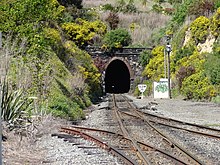Lyttelton Rail Tunnel

Heathcote portal of Lyttelton railway tunnel.
|
|
| Overview | |
|---|---|
| Line | Main South Line |
| Location | Christchurch, New Zealand |
| Coordinates | 43°35′32.15″S 172°42′45.55″E / 43.5922639°S 172.7126528°E |
| Status | Open |
| Start | Lyttelton |
| End | Heathcote |
| Operation | |
| Opened | 9 December 1867 |
| Owner | ONTRACK |
| Operator | KiwiRail |
| Technical | |
| Line length | 2.595 kilometres (1.612 mi) |
| Track gauge |
1,600 mm (5 ft 3 in) (1863–1876) 1,067 mm (3 ft 6 in) (1876–present) |
| Electrified | 1500 V overhead (1929–1970) |
The Lyttelton Rail Tunnel, initially called the Moorhouse Tunnel, links the city of Christchurch with the port of Lyttelton in the Canterbury region of New Zealand’s South Island. It is the country’s oldest operational rail tunnel, and is on the Lyttelton Line, one of the first in the province. On completion in 1867 it became the first tunnel in the world to be taken through the side of an extinct volcano, and at 2.7 km, the longest in the country. Its opening made the Ferrymead Railway, New Zealand's first public railway line, obsolete.
Canterbury’s first settlers had two options for transporting themselves and their goods between the harbour at Lyttelton and the Canterbury plains: the Bridle Path over the Port Hills, or by ship over the Sumner Bar then up either the Heathcote or Avon Rivers.
It was therefore with concern over access to the plains that the Canterbury Provincial Council, formed in November 1853, established four months later a Commission to examine the options for improvement. Only one road route was considered feasible, the Sumner Road passing under the summit of Evans Pass via a 350-yard tunnel. There were two contenders for the rail line: a direct route down the Heathcote Valley and through a 2.5 km tunnel to the Lyttelton foreshore, or a more circuitous route via the Avon Heathcote Estuary and around the shore to Sumner, where a shorter tunnel would take the line to Gollans Bay and Lyttelton.
The inability of the Commission in its final report to make an unequivocal recommendation as to the best option for connecting the port to the plains resulted in plans for the railway to be temporarily suspended. This only exacerbated the problem to the point where, in 1858, Superintendent William Sefton Moorhouse prevailed upon the Provincial Council to consider the matter again. In response, the council set aside £4,000 to engage the services of an engineer and to seek tenders from reputable engineering firms that may be interested in the project.
...
Wikipedia
